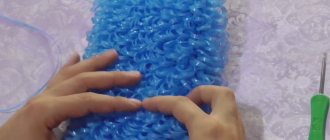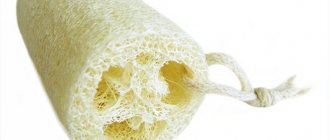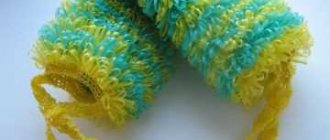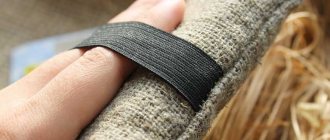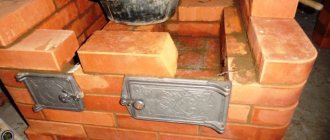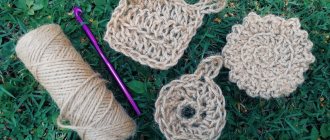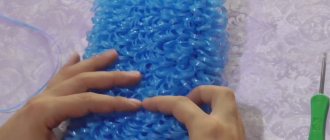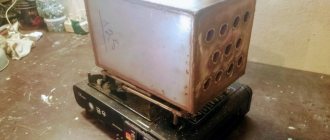Materials
Natural and synthetic materials are used for knitting washcloths. A washcloth made of natural cotton or linen, for example, is suitable for small children or people with very sensitive skin. Such products last very little because Mold quickly appears in natural fibers and can rot.
A washcloth can be knitted from the following materials:
- Linen and cotton. The washcloths are very gentle on the skin, but last no more than a month.
- Polypropylene. The threads look like soft plastic strands. This washcloth lasts for several months, holds foam well and cleanses the skin efficiently.
- Tourniquet. It comes in polypropylene, jute and linen.
- Sisal. Made from agave fibers. The stiff fiber is great for use with scrubs.
- Polyethylene. To knit washcloths, you can use old bags cut into strips.
- Capron. A flat washcloth can be made from old tights.
- Sock additive. Stiff threads that are added to the warp yarn when knitting the heels of socks.
- Viscose is a thread made from wood fiber.
- Acrylic.
- Sackcloth.
To ensure that the finished knitted washcloth not only looks impressive in the photo, but is also soft, after finishing work it is immersed in hot water for 15 minutes.For knitting, hooks with a rounded head are used. The diameter of the hook depends on the thickness of the material used.
What materials are used to make washcloths?
Cotton. Washcloths will have properties such as gentle exfoliation and improved blood circulation. Suitable for those with sensitive skin types, as well as children.
Leg-split. A feature of this material is its high strength. A product made from twine will definitely last a long time.
Polypropylene. If you need a durable washcloth that removes grease well, this material is for you.
Sisal. Washcloths for massage are knitted from it. Very durable material with a long service life. A special feature is the preservation of rigidity.
Viscose obtained from pine wood. Provides product strength.
Acrylic. This synthetic fiber is very durable, the washcloth will last a long time.
Bags. If you don’t have yarn on hand, it doesn’t matter. You can wash a flour or sugar bag and unravel it.
It is better to choose a hook depending on the diameter of the yarn used. It is better if it has a rounded end.
Loofah with extended loops
If you're just getting started with crocheting, knit a flat washcloth with loops. The more loops there are, the fluffier the washcloth will be and the more yarn you use. To save money, loops on the washcloth can be made on only one side. If necessary, “fluffy” rows can alternate with flat rows.
Knitting a washcloth with elongated loops occurs in the following sequence:- Cast on 40 stitches and close them into a circle.
- Knit 7-10 rows without crochets.
- The transition between tiers is carried out using air loops. Also, at turns, you can knit 3 double crochets from one loop so that the fabric does not form wrinkles.
- After the 10th row, start pulling stitches. To do this, knit a regular stitch and stretch the working thread with your finger to the desired length. The loops can be left behind or in front of the work.
- When the washcloth reaches the desired length, finish knitting.
- At the end, tie a chain of air loops - the handle of a washcloth. Tie and secure the handle on the back of the product.
How to knit a washcloth? Basic moments
The process of knitting a washcloth includes a number of stages:
- The choice of material for the washcloth.
- Selection of knitting tools.
- Choosing the shape of the washcloth.
- Directly knitting a washcloth.
Let's look at these steps in more detail.
What material to choose for knitting a washcloth?
Today you can see in stores washcloths made of different materials, differing in hardness, durability and other properties. The most common option is DIY polypropylene washcloths. These are what grandmothers sell at the market. Polypropylene is a cheap, wear-resistant material that perfectly retains its shape and has good rigidity, which makes it possible to efficiently remove the stratum corneum of the skin. Polypropylene thread can be easily found in any craft store; the color range of such yarn is huge. Polypropylene threads are offered by different manufacturers, so its price range is quite wide: the cheapest options are offered by domestic and Chinese companies, expensive brands are offered by Italian ones.
The disadvantage of polypropylene is that it is artificial, therefore it can cause allergies and is not suitable for people with sensitive skin.
Do you prefer washcloths made from natural materials? Pay attention to the bast - fibers extracted from the inside of the linden tree. This material makes durable and environmentally friendly washcloths; they cleanse the skin well and have a beneficial effect on the body thanks to the phytoncides released when the fibers are heated.
A well-known and popular material for washcloths is loofah. For its production, fruits of the pumpkin family are used. Loofah is tough and can be used to effectively scrub the body, removing all dead cells. Loofah washcloths are especially popular among women, as they are good helpers in the fight against cellulite.
Sisal, a material made from the fibers of tropical plant leaves, will help get rid of orange peel and effectively cleanse the skin of impurities and dead skin layers.
If we return to the origins and traditions of the Russian bath, we suggest paying attention to flax. This material is perfect for washcloths; it has high strength, long service life, environmentally friendly composition, a pleasant aroma and has a healing effect on the body.
Want a little exotic? Pay attention to the ramie washcloth - Chinese nettle. It has medium hardness, so it is suitable for any skin type. Thanks to the substances contained in the fibers, the washcloth has an anti-inflammatory and rejuvenating effect.
But not each of the above materials is suitable for knitting washcloths for a bath with your own hands. As already mentioned, the simplest and cheapest option is polypropylene threads for washcloths. You can also use sheep or goat wool, silk threads for sensitive skin, nylon threads, cotton or linen yarn.
Which tool to choose for knitting a washcloth?
Knitting washcloths can be crocheted or knitted. Both options make it possible to realize any idea and knit a washcloth of any size and shape.
The choice is based on personal preferences and skills, if you know how to crochet, then knit with it, if knitting needles are closer to you, then choose this method of knitting. As a rule, the product is knitted faster, but most people use a crochet hook.
If you have never knitted before, it is preferable to start with a hook; it is easier to work with than with knitting needles.
We recommend reading:
Pellets for stoves and fireplaces
Washcloths for a bath should be knitted loosely, without pulling the thread too tightly. This is necessary to make the washcloth flexible and soft. If you want the washcloth to foam better and be even softer, you can insert a piece of foam rubber into it.
Spiral sponge
This type of washcloth may contain 2 or more colors. It can be knitted either in a flat pattern or using the “grass” technique. Begin knitting with a set of 47 basic loops, which are closed into a ring.
The following are step-by-step instructions for knitting a washcloth:
- Knit one row with simple stitches.
- Knit 6 stitches of the row with the main color.
- Add extra thread. Knit the next 6 stitches.
- Knit the next 6 stitches again with the main color.
- Alternate colors until you reach the length you want.
- Finish knitting with a row of double crochets.
- Knit handles from the base loops and sew them on both sides of the washcloth.
Video lesson:
Washcloth without elongated loops
Work begins with a set of 30 air loops. The resulting chain is looped, and two rows are knitted with single crochets. The next row is knitted with single crochets. Next, the main pattern is knitted, consisting of three double crochets, with a gap of two double crochets between them.
The result is a beautiful pattern that also closes into a ring. This three-stitch pattern is repeated on all subsequent rows until the remaining length of the washcloth is knitted. The washcloth ends, as it began, with two single crochets. The washcloth is almost complete, all that remains is to tie the handles.
Baby hedgehog washcloth
Using the same technique of elongated loops, which is also called “grass” or “fur,” you can knit a simple baby washcloth. For babies, use soft natural yarn, and for older children, synthetics.
- Cast on 35 initial stitches and cast off the circle.
- Knit 2-3 rows with stitches.
- Next, knit 25-30 rows in the round with long loops.
- Attach an additional thread for the muzzle and continue knitting with it.
- In each row, decrease 4 loops until 1 loop remains on the hook.
- Close the knitting.
- Using the main color, embroider the nose and eyes of the hedgehog on the face.
The edges of the washcloth can be sewn together or the washcloth can be left hollow so that it can be placed on your hand.
How to crochet hard and soft
Crocheting a washcloth can be difficult for beginners, but step-by-step instructions will help you get the job done. The main thing is the ability to knit a lush column.
For a double-sided washcloth, a No. 4 hook and any polypropylene yarn are suitable. The future washcloth can be either plain or beautiful multi-colored.
The sides turn out to be different - one is hard, knitted lengthwise, and the other soft, knitted across:
- 1st step – chain. The length of the future washcloth will depend on the number of loops cast on.
- The 1st and 2nd rows consist of sc.
- 3rd row. If the washcloth is multi-colored, then first an air loop is knitted with 2 threads, followed by 2 sc, then a fluffy stitch. It is untied from the originally knitted chain.
To form a fluffy column, you should knit 5 dc and secure them with an air loop. Next come 3 sc and knitting the next lush column. This continues until the row ends.
- 4 row. The first loop is knitted with an air loop, then the sc is knitted into the loops of the previous row. For a multi-colored washcloth, the last loop is knitted with 2 threads at once.
- The 5th row is knitted again with a thread of the first color, chain stitch as well. Next comes the alternation of 3 sc and a lush column, which is knitted from the loop of the last knitted row of the same color.
- Row 6 is knitted like row 4.
- 7th row. If the washcloth is knitted in different colors, a thread of the third color is introduced into the work and row 5 is repeated.
- Row 8 is similar to row 4.
- Continue knitting until the required width of the washcloth is reached.
To knit the soft side, you need to start working from the side of the resulting fabric. This side is knitted in the same way as the previous one, but the fluffy stitches are made from three dcs, not five. And they will alternate not with 3 sc, but with 2. Having finished the 2nd side, both halves are folded and either crocheted around the perimeter or sewn from the inside out. At the request of the knitter.
If the halves were sewn together, then the result is a pipe and the holes still need to be crocheted and then the handles are tied. You can sew cotton braid as handles. To make it soft, scald the washcloth with boiling water.
Loofah ball
Beginning knitters can knit a round washcloth, much like store-bought washcloths. Beautiful folds that form the ball are obtained by knitting several loops from one.
- Cast on 6 loops.
- Knit 2 rows of regular stitches.
- In the third row, knit three new loops from each loop.
- Repeat the increase for three more rows.
- Knit a row of settlements with single crochets.
- Knit a chain of loops for the handle of the washcloth.
- Sew the washcloth to prevent it from unraveling during bathing.
To make a round washcloth more voluminous, you can use double crochets instead of simple stitches.
Knitting patterns
Using patterns for knitting washcloths in your work, you can create different models of bath accessories.
Scheme 1: Oval model
Diagram 2: Round model
Scheme 3: Elongated loops can be made not only with your finger, but also with a school ruler.
Washcloth from bags
If you find a suitable pattern for knitting a washcloth, you can knit it from plastic bags. These can be regular bags without handles or multi-colored garbage bags. Before you start, you need to prepare the packages. For a regular washcloth you will need about 30 pieces:
- Lay a roll of garbage bags horizontally on the table.
- Fold the fabric upwards, leaving 5 cm at the top.
- Cut the folded edge into strips 3 cm wide, not cutting the roll all the way through.
- Expand the packages. You will receive fringe made of polyethylene.
- Make oblique cuts in the upper part of the workpiece, going from the 1st strip to the 2nd, from the 2nd to the 3rd, and so on.
- As a result, you should have a long strip that you can roll into a ball and start knitting.
Round washcloth for washing dishes
You can knit a small washcloth from scratchy synthetic threads or a rope for washing dishes.
- Tie a rectangular pipe using the method described above.
- Sew the edges together using a smaller crochet hook.
- Thread the thread through one corner of the workpiece and pull it through the opposite one.
- Pull the workpiece, you should get a ball with folds.
- Secure the thread and make a loop for hanging.
With the help of a hook and imagination, you can make a wide variety of washcloths in appearance and purpose. And if you take used bags rather than purchased yarn, you will not only decorate your home, but also help the environment.
Photos of beautiful do-it-yourself washcloths for showers and baths
It seems that the washcloths are all the same, differing only in color. But real needlewomen create interesting products for their family and friends.
source
Photo of crocheting washcloths
0
